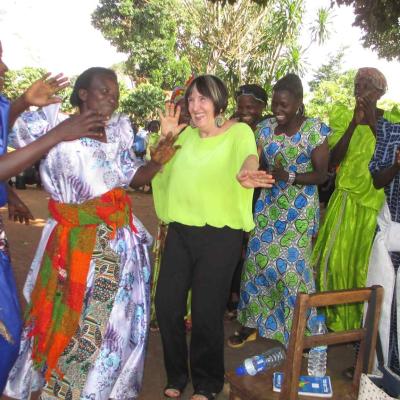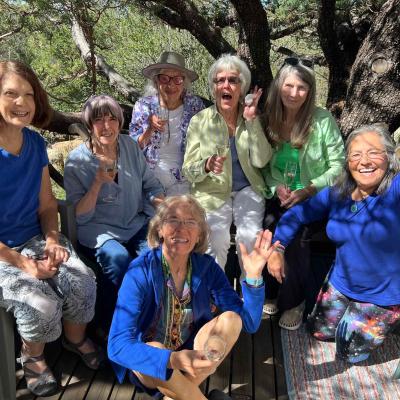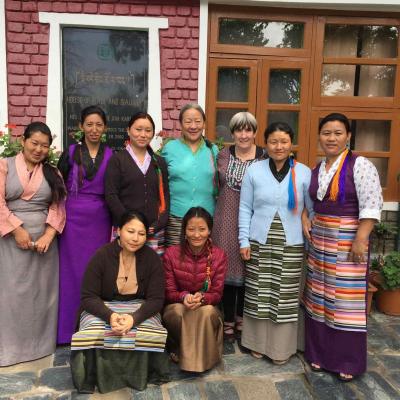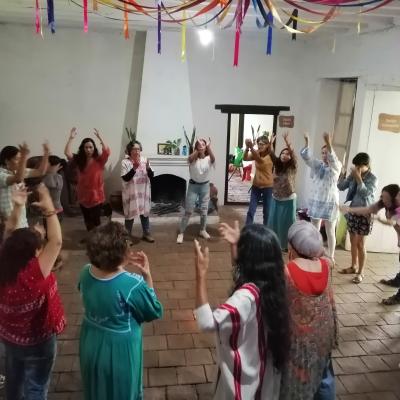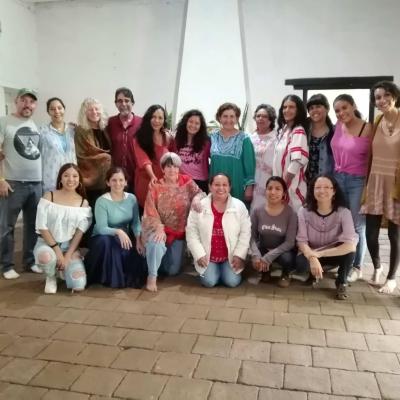A Brief History of Circle
© 2014 Sharon G. Mijares
There is evidence of spiritual ritual gatherings occurring possibly as early as 300,000 years agoi in Middle Paleolithic societies, although little is known about the complexity of these gatherings. Actual evidence is found that communities gathering for spiritual and shamanic experience have been evidenced in the Upper Paleolithic societies (over 30,000 years ago, long before modern humanity). Although there is no written history, there is evidence of ritual art, paint, and other religious ceremonial relicsii, including the first representations of the revered female formiii,iv. This means that human beings have been gathering in purposeful circle for a very long time, and that the central representation of divinity was feminine.
Women equally participated in circles around the fire for ritual and did the same as they prepared food for families and community. During these times they shared stories and tribal experience. Researchers have found much evidence that societies were far more egalitarian in earlier human stagesv.
Tragically, from the onset of patriarchal ideology, and related religious influences, this began to change approximately 6,000 to 4,000 years agovi. This was accompanied by an emphasis on increasing cognitive development, resulting in more linear thinking and behaviors. Prior gathering in circle was replaced to meeting in lines. In this way, both men and women became passive receivers of information and instruction from persons in leadership positions. Thus community and egalitarianism were replaced with patriarchy and resulting divisiveness. Although it became a male-dominant world, it is important to know that there are a few matriarchal societies existing in our world at this timevii Regardless, the dominant metaphor became more linear in that the male-dominated patriarchal model turned away from circle, and hence, from authentic connection.
Many indigenous groups still gather in circles, for example, Native Americans, the Maasai tribe of Kenyaviii, and all the numerous countries throughout Mother Earth where people still engage in ritual circle. These groups regularly gather in circle to confirm the identity of the community through ritual, story-telling, dance and music. In ancient times, both men and women shared stories around the fire, and, in fact, they still do in indigenous tribes. These gatherings provide meaning and direction in life. Gathering in circle is a vital element in human life, and increasing numbers of women are discovering its potency for healing, meaning-making and enriching communications.
The Newer Movement of Women Meeting in Circle
Back in the 80s a feminist movement began with the idea that meeting in circle was a feminine way to share stories and promote healthier communication. It was taking place with Western womenix and also as far away as Africax. They were remembering, consciously or unconsciously, the importance of circle and healthier ways of gathering.
In that there is tremendous support that both men and women met in circle as early as 300,000 years ago, it is not accurate to believe it is only related to the feminine gender. What happened was that as the male image became dominated through patriarchal ideologies and related behaviors, many human beings lost the community that was once encouraged by circle and communal gathering. Historically, earlier societies were naturally more matriarchal as lineage had been based on the mother rather than the father. The rise of patriarchy also meant that lineage would be based on paternity. This new movement of women in circle represented a return to pre-patriarchal communal connection.
Naturally, these wise women, particularly with the circle movement increasing throughout the latter part of the 1980s (as discussed in The Goddess Remembered and in the numerous books emerging in the late 80s and 90s), recognized circle to be a non-patriarchal way of gathering. It was thus a return to a more feminine and egalitarian way of communal experience.
This has resulted in the increasing movement and return to circle gatherings throughout the last 30+ years. Although the indigenous have always maintained communal circle, this is a new movement for the modern women. (Even progressive schools and various meeting places have moved desks and chairs, so that participants are looking at one another as opposed to the more linear expectation of looking at the back of someone’s head.) The association of the feminine with this movement is because egalitarian ways of being are more associated with a healthier sense of gender as experienced in pre-patriarchal times.
Meeting in Circle
When we meet in circle we join to hold everyone in sacred space and purpose. We are bringing forth an ancient way of connecting into modern times. We gather to share stories, to deepen our identities individually and in group—often with the intention to enable and shape a postpatriarchal way of being. We also gather to heal lifexi. We can meet in circle to share our joy, we can meet in circle to work on projects or join in ritual at various levels of depth and purpose, and we can meet in circle to help to change our world.
Jean Shinoda Bolen added to this movement in creating the Millionth Circle Movementxii. Her idea is to both increase and unite the circle movement so that we reach a tipping point and our united goals for a healthier humanity and planet can facilitate a morphogenetic shiftxiii as our united mind creates a significant and positive transformation in the human field of consciousness. Thus our vision and hope for a better world will become a reality. Gather the Women has joined to support this movement.
Likewise, Institutes for Women and Global Change, our articles and new book: A Force Such as the World Has Never Known: Women Creating Change, our workshops and other endeavors join in the movement. In the Dedication for A Force Such As the World Has Never Known, I wrote:
As women connect around our circular earth, we are creating networks--circles within a larger circle, all part of this spiraling galaxy and an expanding field of creative form and force. We carry within us a spark of light initiated with the big bang—that same creative power that birthed the universe. It is time to manifest feminine potential and restore right balance and healing as obviously the force is with us.
The emerging reality would be a gender-balanced world, a healthier world for nature and all species—for we are all related.
-
Andre Leroi-Gourhan and Annette Michelson, The Religion of the Caves: Magic or Metaphysics? October 37, The MIT Press, pp. 6-17. “cave art” born 30,000 years before our era ... would appear to have developed simultaneously with the first explicit manifestations of concern with the supernatural." (p. 6). Excavations and explorations of early gravesites, etc., in the mid Paleolithic indicate religious and shamanic practices (for example, 50,000 B.C.). The middle Paleolithic period is approximately, 300,000-50,000 B.C. There are controversial beliefs about this times, but much can be learned when these findings are compared with studies of more recent hunter-gatherer tribes. Gravesites 50,000 to 100,000 years ago indicate that buried bodies were covered in red ochre, something also seen in the entrances to European Goddess sites. At this time, we know that hunter-gatherer tribes, including those who have been totally (until recently) separated from all modern development, join in circle for story-telling and tribal ritual. It stands to reason that gathering in circle has been occurring for a long, long time.
-
Jonathan Amos (2004-04-15). Cave yields’ earliest jewelry.” BBC News.
http://news.bbc.co.uk/2/hi/science/nature/3629559.stm
-
During Paleolithic era the earliest images of Goddesses appeared.For example, the Venus of Tam Tam, found in
Morocco and estimated to be between 300,000 to 500,000 years old) and the Venus of Berekhat Ram (possibly 230,000 years old was found in Golan Heights). These are the oldest depictions of human form. Both are female. There are male scientists who still argue over their validity (for example, suggesting that the Venus of Tam Tam just happened to be formed by nature—water, earth changes and the like). The more well-known Venus of Willendorf is believed to have been sculptured before 22,000 to 24,000 B.C.E. Numerous of these sculptures were found in excavations, suggesting she was a sacred icon.
-
The name “Venus” associated with these figurines is highly controversial given the ideas of Venus as Aphrodite, a sexual, sensual figure. This was the image of women during the 1900s when these “experts” were finding and naming these depictions of ancient feminine. For more on this visit http://arthistoryresources.net/willendorf/willendorfname.html
-
Anthropologist Agustin Fuentes new book provides a lot of evidence that the modern idea of males and females was not the case in ancient times. Males helped in gardening and food preparation and females hunted small game. Evidence of pre-patriarchal wars and violence did not occur. Agustin Fuentes, Race, Monogamy, and Other Lies They Told You: Busting Myths about Human Nature. 2012/Berkeley: University of California Press.
-
There are numerous sources describing this changes, for example, Merlin Stone, When God was a Woman,
1976/New York: Hacourt, Brace, & Jovanovich, and Marija Gimbutas, The Language of the Goddess. 1991/San Francisco: HarperCollins. A very thorough analysis of all the changes that occurred with the rise of the patriarchal social system is in Sharon G. Mijares, Aliaa Rafea, Rachel Falik and Jenny Eda Schippers’ book The Root of All Evil: An Exposition of Prejudice, Fundamentalism and Gender Imbalance, 2007/Exeter, UK: Imprint Academic.
-
There are approximately 22 existing matriarchal societies at this time. These tend to be more egalitarian in structure, and they allow us to glimpse ancient societal structures that lived in very different ways. H. GoettnerAbendroth. Societies of peace: Matriarchies past, present and future. 2003/Ithaca, NY: Cornell University Press.
-
An intriguing view into an elaborate trance circle dance is seen in the 1992 film Baraka, directed by Ron Fricke. It moves through changes in nature and all the different ways of praying.The word Baraka means blessing in most languages deriving from a common Semitic root.The entire film can be seen on http://www.youtube.com/watch?v=gEyguwQalCI&feature=related The sound track is likewise incredible.
-
The documentary, The Goddess Remembered,Donna Read, 1989, you see Merlin Stone, Carol Christ, Luisah Teish, Starhawk, Jean Bolen, Charlene Spetneck and other influences of the women’s movement in the 80s discussing their experience with recognizing the Goddess and meeting in circle.
http://www.nfb.ca/film/goddess_remembered
-
In their article, The Conception of the Circle of Concerned African Women Theologians: Is it African or Western?, Rachel NyaGondwe Fiedler and Johannes Wynand Hofmeyr show how the African circle movement differed from the Western one. Acta Theologica, 2011 31(1): 39-57.
-
“They mutually discuss how the woman feels about her body, her sexuality and her relationship to self and others. The woman’s healing is then enhanced by joining a women’s group, particularly one that practices women’s spirituality. As women bond and share their stories, they affirm a feminine way of being. The authentic Self is acknowledged and mirrored back to each participant. In this loving, empowering environment the women are able to affirm each women’s experience. These personal narratives need to be listened to and acknowledged so that psychospiritual healing can occur. Women need to learn to trust one another. They are often confused about their feminine identity, as masculine models of behavior have dominated for almost 6,000 years.” Quoted from my chapters, Tales of the Goddess: Healing Metaphors for Women, in Sharon Mijares (Ed.) Modern Psychology and Ancient Wisdom: Psychological Healing Practices from the World’s Religious Traditions, 2003/New York: Routledge Mental Health.
-
This movement is based upon and associated with Jean Shinoda Bolen’s book, The Millionth Circle: How to Change Ourselves and The World--The Essential Guide to Women's Circles, 1999/ Boston, Red Wheel/Reiser, LLC. For more about the million circle movement to gohttp://www.millionthcircle.org/JSB/mc.html
-
The biologist Rupert Sheldrake defined morphogenetic fields and morphogenetic resonance. It is believed that there is a field composed of morphic units. If similar occurrences repeat, there is a great likelihood of overall change within the field. Bolen’s vision is that once enough women (the millionth circle) have gathered in circle the potential to shift the field of consciousness and behavior into a more egalitarian and gender based world can manifest as reality. Rupert Sheldrake; Stanislav Grof, Editor. Morphic Resonance. Seventh Conference of the International Transpersonal Association, 1984/Bombay: SUNY Press, Albany.

